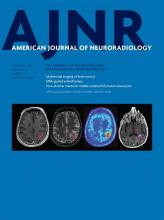Index by author
Schindler, J.
- EXTRACRANIAL VASCULARYou have accessEvaluation for Blunt Cerebrovascular Injury: Review of the Literature and a Cost-Effectiveness AnalysisA. Malhotra, X. Wu, V.B. Kalra, J. Schindler, C.C. Matouk and H.P. FormanAmerican Journal of Neuroradiology February 2016, 37 (2) 330-335; DOI: https://doi.org/10.3174/ajnr.A4515
Sepehry, A.A.
- ADULT BRAINYou have accessPrevalence of Brain Microbleeds in Alzheimer Disease: A Systematic Review and Meta-Analysis on the Influence of Neuroimaging TechniquesA.A. Sepehry, D. Lang, G.-Y. Hsiung and A. RauscherAmerican Journal of Neuroradiology February 2016, 37 (2) 215-222; DOI: https://doi.org/10.3174/ajnr.A4525
Shah, N.J.
- EDITOR'S CHOICEADULT BRAINOpen AccessMultimodal Imaging in Malignant Brain Tumors: Enhancing the Preoperative Risk Evaluation for Motor Deficits with a Combined Hybrid MRI-PET and Navigated Transcranial Magnetic Stimulation ApproachV. Neuschmelting, C. Weiss Lucas, G. Stoffels, A.-M. Oros-Peusquens, H. Lockau, N.J. Shah, K.-J. Langen, R. Goldbrunner and C. GrefkesAmerican Journal of Neuroradiology February 2016, 37 (2) 266-273; DOI: https://doi.org/10.3174/ajnr.A4536
Patients with malignant brain tumors involving the central region underwent a hybrid O-(2-[18F]fluoroethyl)-L-tyrosine–PET-MR imaging and motor mapping by neuronavigated transcranial magnetic stimulation. The spatial relationship between functional tissue and lesion volumes as depicted by structural and metabolic imaging was analyzed. Tumor infiltration of the M1 region or the corticospinal tract as depicted by FET-PET is highly indicative of motor impairment, better than contrast-enhanced T1WI alone, and is of predictive value for operative-risk evaluation.
Shaibani, A.
- NeurointerventionYou have accessAutosomal Dominant Polycystic Kidney Disease and Intracranial Aneurysms: Is There an Increased Risk of Treatment?M.N. Rozenfeld, S.A. Ansari, P. Mohan, A. Shaibani, E.J. Russell and M.C. HurleyAmerican Journal of Neuroradiology February 2016, 37 (2) 290-293; DOI: https://doi.org/10.3174/ajnr.A4490
- You have accessReply:M.N. Rozenfeld, S.A. Ansari, P. Mohan, A. Shaibani, E.J. Russell and M.C. HurleyAmerican Journal of Neuroradiology February 2016, 37 (2) 296; DOI: https://doi.org/10.3174/ajnr.A4657
Shanley, R.M.
- Pediatric NeuroimagingYou have accessIntensity of MRI Gadolinium Enhancement in Cerebral Adrenoleukodystrophy: A Biomarker for Inflammation and Predictor of Outcome following Transplantation in Higher Risk PatientsW.P. Miller, L.F. Mantovani, J. Muzic, J.B. Rykken, R.S. Gawande, T.C. Lund, R.M. Shanley, G.V. Raymond, P.J. Orchard and D.R. NasceneAmerican Journal of Neuroradiology February 2016, 37 (2) 367-372; DOI: https://doi.org/10.3174/ajnr.A4500
Shatzkes, D.R.
- Head and Neck ImagingYou have accessProtrusion of the Infraorbital Nerve into the Maxillary Sinus on CT: Prevalence, Proposed Grading Method, and Suggested Clinical ImplicationsJ.E. Lantos, A.N. Pearlman, A. Gupta, J.L. Chazen, R.D. Zimmerman, D.R. Shatzkes and C.D. PhillipsAmerican Journal of Neuroradiology February 2016, 37 (2) 349-353; DOI: https://doi.org/10.3174/ajnr.A4588
Sheelakumari, R.
- ADULT BRAINYou have accessA Potential Biomarker in Amyotrophic Lateral Sclerosis: Can Assessment of Brain Iron Deposition with SWI and Corticospinal Tract Degeneration with DTI Help?R. Sheelakumari, M. Madhusoodanan, A. Radhakrishnan, G. Ranjith and B. ThomasAmerican Journal of Neuroradiology February 2016, 37 (2) 252-258; DOI: https://doi.org/10.3174/ajnr.A4524
Shirato, H.
- EDITOR'S CHOICEHead and Neck ImagingOpen AccessUsefulness of Pseudocontinuous Arterial Spin-Labeling for the Assessment of Patients with Head and Neck Squamous Cell Carcinoma by Measuring Tumor Blood Flow in the Pretreatment and Early Treatment PeriodN. Fujima, D. Yoshida, T. Sakashita, A. Homma, A. Tsukahara, K.K. Tha, K. Kudo and H. ShiratoAmerican Journal of Neuroradiology February 2016, 37 (2) 342-348; DOI: https://doi.org/10.3174/ajnr.A4513
Forty-one patients with head and neck squamous cell carcinoma were evaluated by using pseudocontinuous ASL. Quantitative tumor blood flow was calculated at the pretreatment and the early treatment periods. Pretreatment tumor blood flow in patients in the treatment failure group was significantly lower than that in patients in the local control group. The use of the percentage change of tumor blood flow combined with the percentage change of tumor volume had high diagnostic accuracy for predicting local control.
Shuaib, A.
- ADULT BRAINOpen AccessCerebral Perfusion Pressure is Maintained in Acute Intracerebral Hemorrhage: A CT Perfusion StudyA.S. Tamm, R. McCourt, B. Gould, M. Kate, J.C. Kosior, T. Jeerakathil, L.C. Gioia, D. Dowlatshahi, M.D. Hill, S.B. Coutts, A.M. Demchuk, B.H. Buck, D.J. Emery, A. Shuaib and K.S. Butcher on behalf of the ICH ADAPT InvestigatorsAmerican Journal of Neuroradiology February 2016, 37 (2) 244-251; DOI: https://doi.org/10.3174/ajnr.A4532
Sivapatham, T.
- You have accessReply:S.R. Satti, L. Leishangthem and T. SivapathamAmerican Journal of Neuroradiology February 2016, 37 (2) E17-E18; DOI: https://doi.org/10.3174/ajnr.A4667








